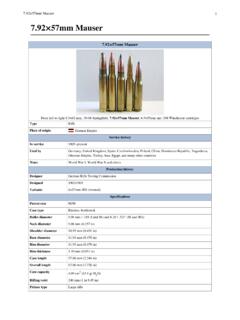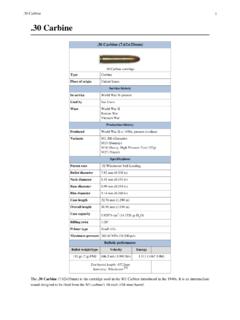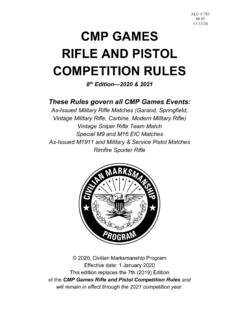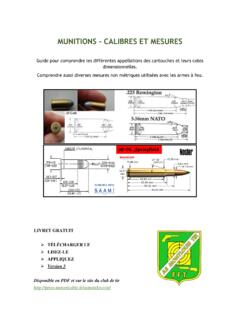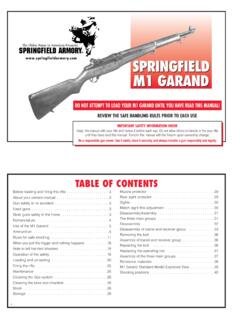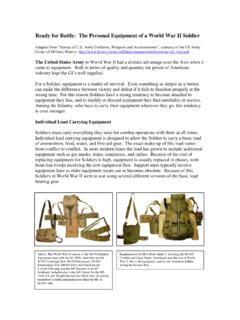Transcription of 7.62×51mm NATO
1 51mm 51mm 51mm 51mm NATO rounds compared to AA (LR6) of origin United StatesService historyIn service1954 presentUsed byUnited States, NATO, War, Falklands Conflict, The Troubles, Gulf War, War in Afghanistan, Iraq War,Libyan civil war, among other conflictsSpecificationsParent Winchester (derived from the .300 Savage)Case typeRimless, BottleneckBullet mm ( in)Neck mm ( in)Shoulder mm ( in)Base mm ( in)Rim mm ( in)Rim mm ( in)Case mm ( in)Overall mm ( in)Rifling twist1:12"Primer typeLarge RifleMaximum pressure415 MPa (60,200 psi)Ballistic performanceBullet g (147 gr) M80 m/s (2,733 ft/s)3,304 J (2,437 ft lbf) g (175 gr) M118 LongRange m/s (2,580 ft/s)3,506 J (2,586 ft lbf)Test barrel length: 24"Source(s): M80: Slickguns,[1] M118 Long Range.
2 US Armorment[2] 51mm NATO2 The 51mm NATO (official NATO nomenclature NATO) is a rifle cartridge developed in the 1950s as astandard for small arms among NATO countries. It should not to be confused with the similarly named 54mmR was introduced in service in the M14 rifle and M60 machine gun in the late 1950s. The M14 was supersededin service as the infantry adopted the 45mm NATO M16. However, the M14 and many other firearms thatuse the 51 round remain in service, especially in the case of sniper rifles, machine guns, and as the serviceweapon chosen by special operations forces.
3 The cartridge is used both by infantry and on mounted and crew-servedweapons mounted to vehicles, aircraft and not identical, the 51mm NATO and the commercial .308 Winchester cartridges are similar, and eventhough the Sporting Arms and Ammunition Manufacturers' Institute (SAAMI) considers it safe (by not listing it) tofire the NATO round in weapons chambered for the commercial round, there is significant discussion[3][4][5] aboutcompatible chamber and muzzle pressures between the two cartridges based on powder loads and wall thicknesseson the military vs.
4 Commercial rounds. The debate goes both ways, the ATF recommends checking the stamping onthe barrel; if you're unsure, consult the maker of the firearm.[6][7]OverviewThe cartridge itself offers similar ballistic performance in most firearms to the .30-06 springfield that it replaced service. Though shorter, standard loadings fire similar bullet weights with only a slight reduction in propellants allowed for similar performance from a case with less capacity. The smaller case requires lessbrass and yields a shorter cartridge.
5 This shorter cartridge allows a slight reduction in the size and weight of firearmsthat chamber it, and somewhat better cycling in automatic and semi-automatic comparison between the 51mm NATO, .30-06 springfield , and .300 Winchester Magnum for common bullet that would eventually developthe 51mm NATO started justafter World War I when the large,powerful .30-06 cartridge proveddifficult to adapt to semi-automaticrifles. A less-powerful cartridge wouldallow a lighter firing mechanism.
6 Atthe time the most promising designwas the .276 Pedersen. When it waseventually demonstrated that was suitable for semi-automaticrifles, the .276 was when war appeared to belooming again only a few decadeslater, the .30-06 was the only roundavailable and the M1 garand providedUS troops with greater firepower thantheir bolt action-armed opponents. TheGarand performed so well that the US saw little need to replace it during World War II and the.
7 30-06 served wellbeyond the Korean War and into the mid the 1940s and early 1950s several experiments were carried out to improve the garand . One of the most common complaints was the limited capacity 8-round en-bloc clip and many experimental designs modified 51mm NATO3weapon with a detachable box magazine. springfield Armory's T20 rifle was a fully automatic version. Though notadopted, experience with a fully automatic garand laid the groundwork for its BMG, .300 Winchester Magnum.
8 308 WIN( NATO), 39mm, NATO, and . recovered 51mm NATO bullets (nextto an unfired cartridge (Tracer ammunition),showing rifling marksThe test program continued for several years, including both theoriginal .30-06 round and a modified .300 Savage (then known as theT65). In the end, the T65 cartridge demonstrated power roughly equalto the original .30-06, firing a 147-grain bullet at 2,750 feet per second(840 m/s) but was approximately half an inch shorter. The eventualresult of this competition was the T44 the United States developed the T65 cartridge, the Britishmilitary took a different route.)
9 They had spent considerable time andeffort developing the intermediate-power .280 British (7 mm) cartridgewith an eye towards controllable fully automatic fire. The US held toits desire not to reduce the effectiveness of individual aimed shots. TheAmerican philosophy was to use automatic fire for emergencies onlyand continue to use semi-automatic fire the majority of the time. Afterconsiderable debate, the Canadian Army announced they would behappy to use the .280 but only if the did as well.
10 It was clear was not going to use the .280. The British did start introducing along with the "bull-pup" Rifle No. 9, but the process was stoppedin the interests of harmonization across NATO. The T65 was chosen asthe NATO standard cartridge in T44 was adopted as the M14 in 1957. Britain and Canada adoptedthe Belgian FN FAL around the same time followed by West Germanarmy as the G1. The Germans soon transitioned to a modified versionof the Spanish CETME rifle, Heckler & Koch G3. With all three ofthese firearms, it was clear that the NATO could not be firedcontrollably in fully automatic because of recoil.

